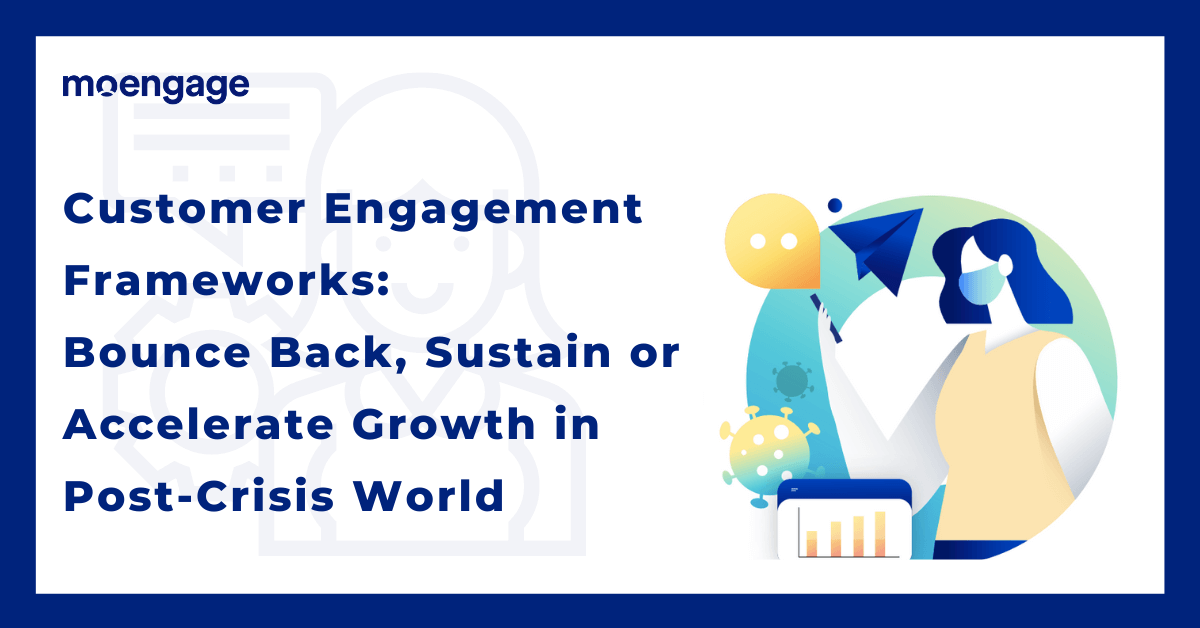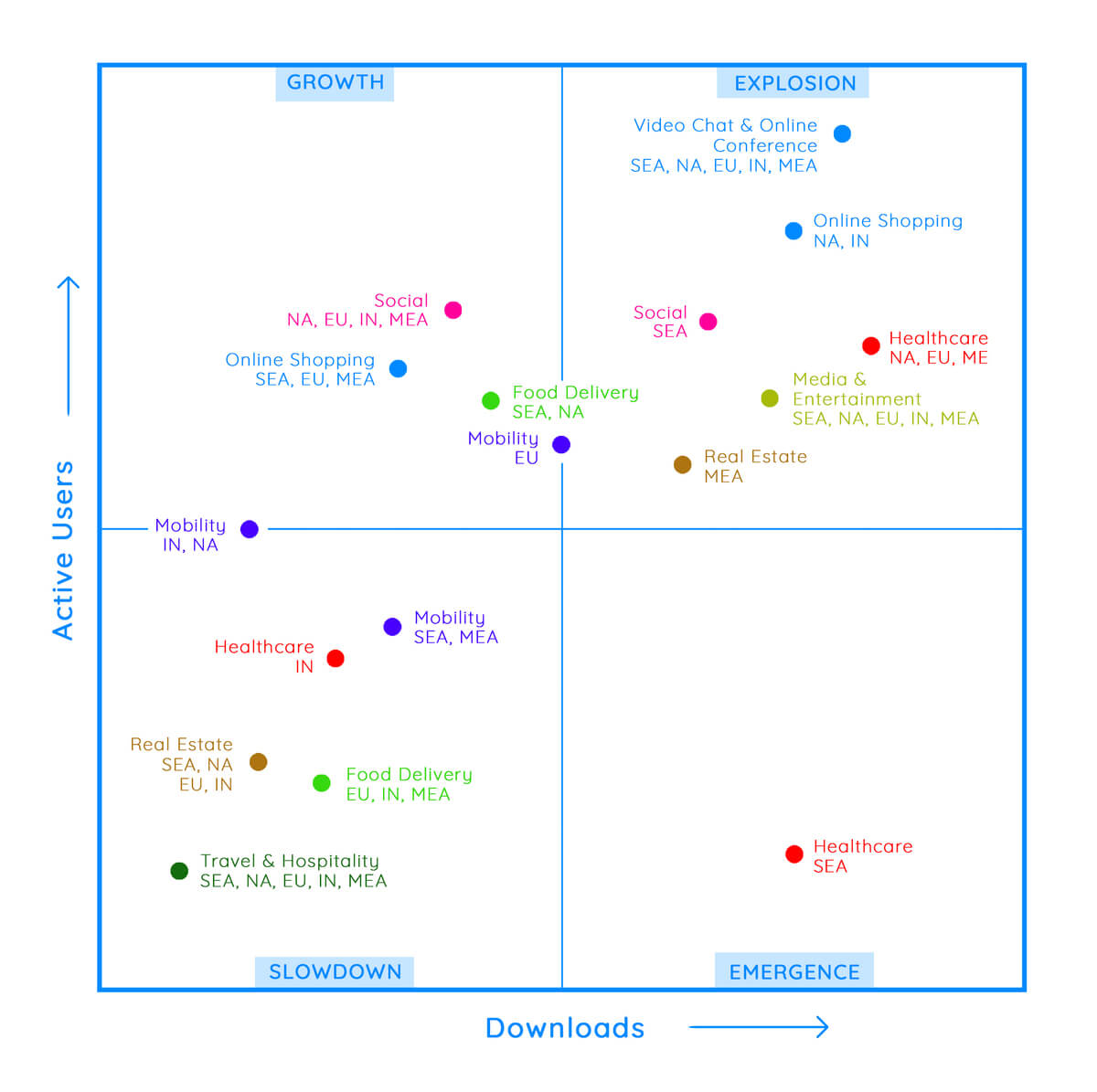3 Actionable Customer Engagement Frameworks For Post-Crisis World

Reading Time: 8 minutes
The global health crisis caused by COVID-19 had a far-reaching impact on businesses across all verticals and geographies. While businesses are responding to the crisis in their own way helping users, whether it is providing free delivery, offering access to premium features, or in some cases deferment of payment, devising actionable customer engagement frameworks is equally important. It is no secret that customer confidence has taken a hit with users hesitant to step out and travel like before. There has also been a paradigm shift in usage and buying patterns with customers preferring to spend on essentials rather than luxury buys.
|
Bonus Content 👉 Definitive Buyer’s Guide To Customer Engagement Platform [Ebook] 👉 Retail Strategies and Omnichannel Engagement Frameworks [Ebook] |
Such a permanent shift in user behavior has forced marketers to look at their engagement strategy and rethink their approach. In our previous COVID-19 impact quadrant, we looked at how this changed behavior impacted brands.

As you can see in the above impact quadrant, industries were affected in the following ways:
- Some verticals like media and entertainment and video conferencing (and chat) noticed unprecedented growth owing to the bump in usage with organizations (and individuals) adopting apps like Zoom (check out these tips for Zoom), Google Meets to stay connected.
- Owing to lockdown restrictions, industries like travel and hospitality, and mobility have suffered from an unexpected drop in business.
- Depending upon the geography, some industries viz. banking and fintech have observed minimal impact in the sense that they have neither seen huge growth nor a heavy decline in usage.
The questions that needed to be answered next were:
- How do brands sustain this newfound growth?
- How do industries experiencing a dip in traffic and revenue bounce back?
- What steps should be taken by brands to accelerate growth after the lull period?
In order to help our community of marketers and product owners find the answer to these questions we partnered with AppFollow and collated insights from marketing leaders across 50+ global brands. These proven, real-world customer engagement strategies (covered in our Customer Engagement Playbook During Crisis below) have enabled us to create ready-to-implement frameworks that will help brands sustain their newfound growth, bounce back to pre-COVID numbers, and accelerate growth.
Without further ado, let’s dive right into these actionable customer engagement frameworks along with strategies that will help you drive growth in a post-crisis world:
Check out the comprehensive Customer Engagement Playbook complete with expert insights, real-life use cases, proven tactics, and a path assessment checklist that will help you identify whether you need a growth sustaining, bounce-back, or growth accelerating strategy.
Growth-sustaining customer engagement framework
If your business happens to show growth during the crisis, naturally it is time to ensure the growth curve is sustained well after normalcy returns. The focus here should be engaging users while building a long-lasting relationship with them.
What are the steps involved in implementing the growth sustaining framework?
- Assess your user acquisition trends to identify the impact on your CAC and LTV. Establish an omnichannel approach to acquisition if you already haven’t. You need to prioritize your acquisition spends based on channel ROIs (organic or paid). It is never a bad idea to ramp up organic growth. If you notice acquisition across a channel went up at the same cost i.e. reduction in CAC, focus on that channel more.
7Mind, Germany based mindfulness app noticed a drop in CPI/CPS when compared to other channels during the peak of the pandemic. The brand immediately doubled down on the aforementioned channel and similar avenues to acquire new customers.
- Understand and track user events like app opens and product searches to decipher the evolving behavior trends, segment them into cohorts based on said behavior, and engage (target) them using triggered communication. Mapping dynamic user flow for each customer will allow you to send relevant, personalized, and spam-free communication.
Shermaroo.me one of India’s leading OTT platforms leveraged the opportunity of creating relevant content, by releasing ‘watch from home’ tray to cater to the increased viewing time. The brand also launched a ‘AbRumour Nahi Humour Phailega’ campaign to lift up the moods of viewers through a selection of feel-good movies and comedies. The entertainment provider further sympathized with users by going international with their content and keeping the library free for two weeks.
- Revisit your value proposition and refresh it according to the changing customer needs. The value-added benefits will go a long way in differentiating your brand from the competition and will also help in keeping loyal users active on your platform. The refreshed value proposition based on the current scenario can be something as simple as waving off extra charges on local deliveries as offered by the North American on-demand ready-to-eat online food delivery app, DoorDash.
Another interesting example comes from the entertainment app Disney+ Hotstar, which tied up with Indian fitness brands like Cult.Fit, Sarva Yoga, and Brilliant Wellness to stream tailor-made, fitness videos for stay-at-home folks during, on top of their regular content.
Bounce-back customer engagement framework
In case the crisis has affected your brand in a negative manner, taking a toll on your DAU/MAU and download numbers, then it is time to focus on the single most important thing: retaining existing users. Chances are due to the adverse impact on your business, new user acquisition might be deprioritized, in such a scenario, retaining current users make perfect sense, now more than ever.
How do you go about structuring a framework essential for bouncing back to the pre-crisis business numbers?
- Analyze and optimize your acquisition channels by evaluating your paid strategy. It is the best time to focus on unexplored organic avenues like ASO and ramp up app reviews to build user confidence. Simple tweaks like localization, targetting crisis-related keywords and, making communication more empathetic can do the trick. Since user retention is the mantra, it only makes sense to optimize your best-performing campaigns according to the current scenario while ensuring you provide the right product along with a seamless user experience. This is also the time to revisit your previous paid strategy and invest in the channels that have provided anywhere between 50-100% ROI.
One of the top Indian mobility brands, Zoomcar offering self-drive car rentals changed their communication during the pandemic to activate high LTV users thereby retaining them. They accomplished this by optimizing their previous high-performing campaign by tweaking the messaging from ‘why buy a car when you can rent one’ to ‘ongoing pandemic might not be a right time to buy a car’; why not rent one instead?’. This change in messaging on top of their best-performing campaign yielded more car rental subscriptions thereby adding to the brand’s bottom line.
- As a business, if you have more than one performing category, a crisis is the perfect time to evaluate how categories other than your primary category is performing. If any sub-category shows promise, try engaging your existing users via that. Leverage actionable engagement tactics to move users down the funnel and rehaul your value proposition accordingly if it can resolve your user’s current pain points.
One of India’s leading e-wallet and digital payments app, PhonePe noticed a surge in activity volume and order value for bill payment during the crisis. The brand quickly made changes to the app’s home page making bill payment and recharge category prominent and pushing the offers/discounts below, thereby making the platform more helpful and relevant to the users at the given time.
- A global pandemic or any crisis for that matter isn’t a good time to be pushing sales communication. Does that mean you as a brand go radio silent? Absolutely not! There is no better time than now to invest in your user community and build your brand image. Brands that will come out of the crisis as winners are those who engage actively with the user community with empathetic messaging and genuinely try to help them. You can create bite-sized content viz. videos, quizzes, and games to engage users and reduce their anxiety.
One of the brands that aced this is OYO, who saw a decline in business owing to the nature of their offering. They quickly turned to gamification in their app to engage inactive users and ensure communication even when their services are on pause owing to the mandatory lockdown. The brand also released newsletters to let the users know what others in the community are doing during the pandemic, thus showcasing their empathy and willingness to help during a global health crisis.
Growth-accelerating framework for sluggish growth
If your business has neither observed burgeoning growth nor rapid decline, then your focus should be on building brand loyalty and re-evaluating your acquisition channels and spends, in order to identify the most ROI effective channel and diverting most efforts there. Another approach to building brand loyalty is creating a strong user community by providing your customers with a platform to actively engage with each other and with your brand.
What is the correct approach to building a growth-accelerating strategy and framework?
- Since your business has been largely unaffected, now is the perfect time to build an acquisition strategy that has a good blend of paid and organic channels. For every two proven paid channels, bring two organic channels into the mix. Invest in channels that have been shown to generate 50-100% ROI. And last but definitely not least, focus on low-hanging options that generate optimum ROI like app ratings and reviews.
- If you are a brand that provides an offering that can be moved online, it is time to do so. During the COVID-19 pandemic, a lot of brands with offline offerings suffered as users couldn’t access them. With digital transformation being one of the widely sought-after models you should seriously consider this option to better reach and engage your users.
One of the examples comes from the entertainment industry with Airtel Wynk Music organizing virtual concerts, providing artists and users the opportunity to enjoy while staying at home. The app created playlists and used push notifications to alert users about these virtual concerts. The brand also took this opportunity to create personalized playlists to engage users while they are stuck working from home during the lockdown.
- Building a long-lasting relationship with your user community is never a bad idea, but it is all the more important during a crisis to stay connected with your customers. Engage users through Facebook groups, Instagram handle(s), and other community platforms using bite-sized content viz. videos, quizzes, polls, AMA sessions, etc. Health and Fitness brands globally have leveraged this perfectly by organizing live online sessions led by experts, where users can communicate and exercise with each other. Another way to resolve user pain points while keeping the community engaged is by providing services that might be outside your immediate offerings purview.
One example comes from the Australian online liquor delivery service, Jimmy Brings, who noticed users were complaining about a shortage of toilet paper and started on-demand delivery of that along with their usual offering, thus boosting their business and earning customer goodwill.
Download the complete e-book to learn about the strategies and frameworks in detail.
Here’s What You Can Do Next
|







